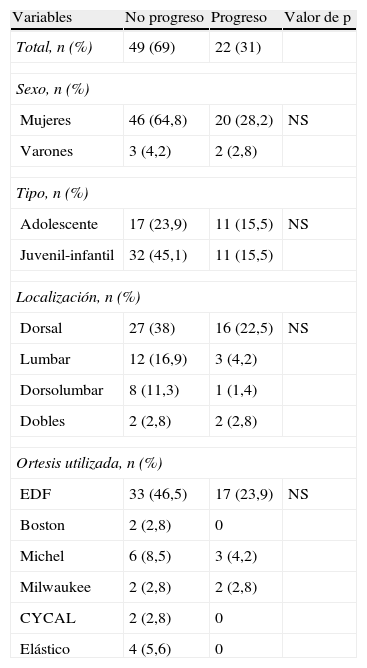Valorar la evolución del valor angular de la escoliosis idiopática tratada con ortesis en el adulto joven.
Paciente y métodoEstudio retrospectivo de 71 pacientes con escoliosis idiopática tratados con ortesis entre 1978-1996. Se incluyen los que acudieron a visitas de control postalta. Se excluyen los que precisaron cirugía y los que su edad era mayor de 40 años. Se compara el grupo que progresa y el resto por las siguientes variables: a) morfología y clasificación de la curva; b) tipo de escoliosis: adolescente, juvenil e infantil; c) valor angular de Cobb al diagnóstico, final del tratamiento y último control; d) ortesis utilizada; e) duración del tratamiento; y f) tiempo de evolución (entre la retirada de la ortesis y el último control).
Análisis estadísticoEn variables categóricas se usó la Chi-cuadrado y en continuas con distribución normal, la t de Student. Para el resto, pruebas no paramétricas. Se asumió un nivel de significación estadística p<0,05.
ResultadosLa curva progresó en 22 pacientes (31%), con una media de 9,5° (DE:4,5) en 9,7 años. El grupo que progresó presentaba valores angulares mayores al inicio (dif:3,9; IC 95%:−1,76 a 9,6), al final del tratamiento (dif:4,8; IC 95%:−1,6 a 11,2), y de forma significativa en el momento del último control (dif:14,5; IC 95%:7,9-21,1), sin diferencias entre las demás variables estudiadas.
ConclusionesLa progresión fue de 2,8° durante 8 años. El 69% no progresó vs. 31% que progresó 9,5°.
This study has aimed to evaluate the evolution of idiopathic scoliosis treated with a brace and assess its progression in young adults.
Patient and methodA retrospective study of 71 patients with idiopathic scoliosis treated with a brace between years 1978-1996 was conducted. It included patients attending post-discharge visits and excluded those requiring surgery and age>40 years. Two groups were compared: patients in whom the scoliosis had progressed and those in whom it had not progressed. The following variables were studied: a) morphology type and classification of the curve; b) type of scoliosis: adolescent, youth and child; c) Cobb angle value on diagnosis, at end of treatment and at last control; d) brace used; e) orthotic treatment duration; and f) evolution time (between removal of brace and last control).
Statistical analysisChi square was used for comparative analysis for categorical variables and the Student's t test for continuous variables with normal distribution. Nonparametric tests were used for all other variables. A statistical significance level of P<.05 was assumed.
ResultsThe curve progressed in 22 patients (31%), with a mean increase of 9.5 (SD:4.5) during 9.7 years. The group with progression had higher angle values at baseline (dif:3.9; 95% CI:−1.76 to 9..6), end of treatment (dif:4.8; 95% CI:−1.6 to 11.2), which were significant at the last control (dif:14.5; 95% CI:7.9-21.1), with no differences between the other variables studied.
ConclusionsProgression was 2.8° over 8 years. There as no progression in 69% compared to 31% who progressed 9.5°.









